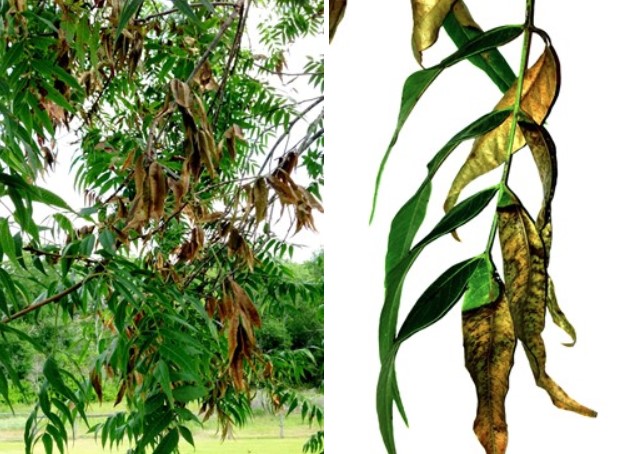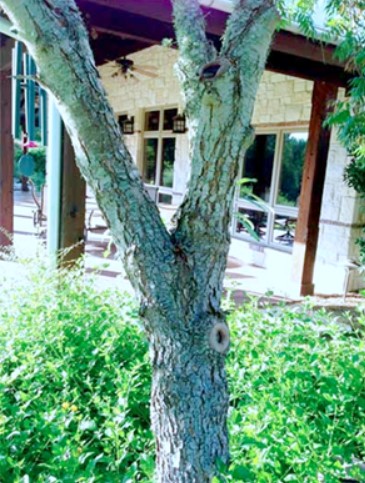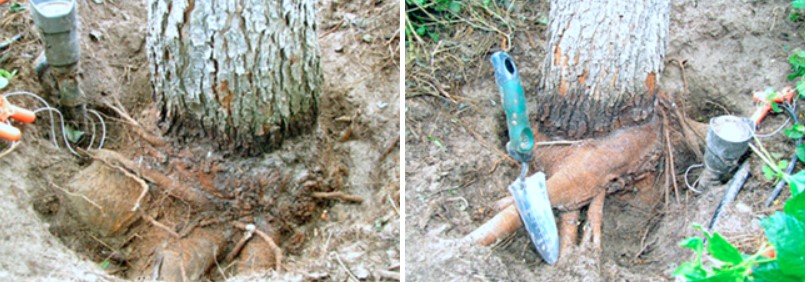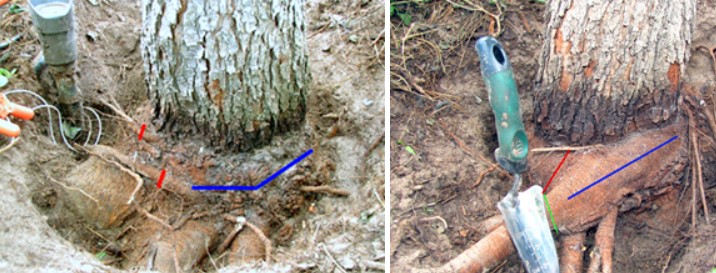Girdling Roots


Published August 27, 2013, By NEIL SPERRY and STEVE HOUSER

The two photos above were posted by a regular friend and visitor to our page, a doctor from the Bryan/College Station area. He's a skilled gardener and a fine scientist, so I knew I'd have to bring my "A game." My problem was, I wasn't even sure where my ball and glove were. I didn't have a clear idea of what might have been causing random leaves on his Chinese pistachio to turn brown.
I told the doctor that I suspected perhaps squirrels or birds chewing on the twigs, much as they do to live oaks. He said that wasn't the case, and he posted another photo of the trunk of the tree with bark missing and lichens growing.

That's when I asked our friend Steve Houser and his team from an expert tree care company in the Dallas/Fort Worth metroplex to take a look. I told Steve that the trunk didn't look right, and I pointed out the area of decay on the trunk, but I still was at a loss as to what might have been going on.
Here is what Steve wrote back:
"I wanted to check with several other arborists in the field. If it is out there, they are going to see it.
"The most likely suspect is girdling roots. A number of our arborists care for trees that have the same problem every year as the temperature exceeds 90 degrees. In this case, the tree is not old or large and appears to have more mature bark than what we typically find on this size of pistachio. As you noted, the bark just does not look right.
"I would suggest that the doctor carefully dig around the base of the tree, to look for roots that girdle or circle around the base (or each other), rather than emanating outward in all directions. You can typically excavate a small area with a pocketknife or small hand trowel, but it must be done carefully to avoid damage. I also try to rock the smaller trees by hand, and if the ground moves with the trunk, girdling roots are the most likely cause. Please let us know what he finds after the excavation."
That's when the real miracle began to unfold. The doctor sent back these two photos.

And that's when I wrote back to the man I now refer to as "Mr. Houser" (new level of respect) and said, "You're going to pop your buttons! Great call!
“Do you have any further suggestions of what our doctor friend might want to do?"
To which he replied:
"When it comes to severe girdling root problems, each case can be a little different, and each is best judged by a knowledgeable arborist inspecting the tree as well as the conditions on the site.
"As a general rule, the primary objective is to minimize crossing or girdling roots that bind on the main trunk and/or root flare (or root collar) at the base of the tree. As a secondary objective, we also try to minimize girdling roots that grow outward, if possible. If a small tree has roots that circle around the trunk or area near the base, it may not be a problem. However, as both the roots and the trunk expand over time, they create pressure on each other. This restricts the normal flow of water and elements in this part of the vascular system. As a result, the health of the tree can suffer over time and the roots may not offer adequate structural support for the weight of the upper canopy.
"If we must cut girdling roots, they should be a reasonable size in comparison to the size of the trunk. In this case, the tree appears to be around ten inches in diameter. Therefore, a two-inch root could be removed but not a five-inch root (or roots) in one growing season, due to the potential for future health concerns. Roots must be cleanly cut, and a sealant should be applied immediately, to reduce the potential for pathogen entry. Personal preference is orange or amber shellac, but a light coating of aerosol pruning paint will work.
"If the tree in question is structurally unstable before any girdling roots are cut, it may be wise to replace it. If the root system is stable, an effort could be made to remove some of the roots over a long period of time. However, it is always risky, because each root provides for the needs of a portion of the tree above ground."
With all of the photos assembled before him, Steve Houser worked with the doctor to provide, at my request, some long-distance guidance in solving this tree's problem. Here is what Steve has suggested.
"Assuming the root system is reasonably stable, you can consider cutting a few of the roots over a period of time. Keep in mind that anytime we cut many roots, it increases the potential for dieback in the canopy or the loss of the tree, and it decreases the structural integrity of the root system (the tree can fall over). There is some gamble involved, but given the cost and time to replace the tree, it seems to be worth the risk.

"The primary objective in the long term is to remove the large root binding on a significant portion of the base. If you look at the two photos attached, the blue line marks the general area of primary binding root. Although it is tough to judge by looking at photos, it appears the roots to cut the first year are marked with a red line. The optimal time to cut them is mid-October. My second photo also shows a green line, and I would wait around two years before making this cut, assuming the health and stability of the tree are good. After two to three more years, this particular root (or the two downward-growing roots) may be cut back farther if necessary to prevent binding at the base.
"A few additional thoughts:
"You may need a handsaw to cut the roots, and you want to avoid damage to the trunk as well as nearby roots. As you cut the larger root near the trunk, it may be embedded in the main trunk and tough to cut with a handsaw. If this is the case, you may need to remove several sections of the root farther away from the trunk and then make the final cut near the trunk. Since your saw may not fit into the embedded section, you may need a wood chisel and hammer to carefully remove the fibers, leaving a straight or flat cut on the root.
"Since you will need to cut roots again in the future, you may want to backfill with larger river rock or a material that is easier to remove next time. However, leave the root flare or root collar clear of any material."
Steve Houser
Final comment from Neil:
I need to point out for all who read this, this is not the way that Steve and his team conduct their business normally. They are always going to refer you to your local certified arborist. They are incredibly supportive of others in their industry. I was just so taken by the nature of this problem befalling a tree that normally doesn't have many problems. And, I was amazed at what Steve Houser and his team helped us discover. What a textbook example. Thanks, too, to our doctor FB friend for providing all the photos we have requested. Great information, everyone!

